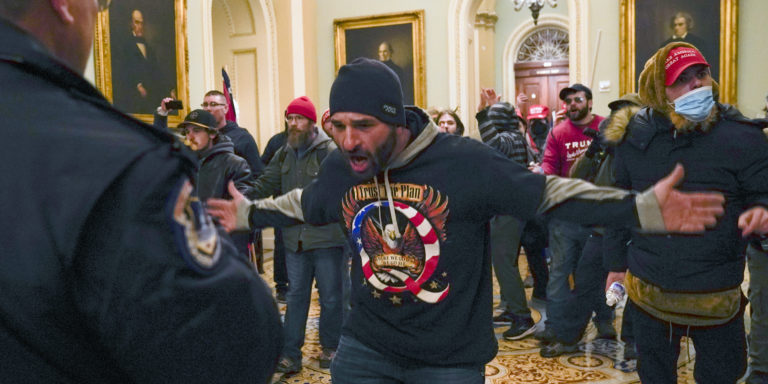INTELBRIEF
January 7, 2021
IntelBrief: U.S. Capitol Stormed by Violent Pro-Trump Mob in Unprecedented Challenge to Democratic Process

Bottom Line Up Front
- Angry mobs stormed the U.S. Capitol to challenge the outcome of the 2020 Presidential election.
- As Congress convened to certify the election results, President Trump incited his supporters to ‘show strength,’ refusing to concede his loss.
- The imagery from the Capitol will serve as critical propaganda for violent far-right extremists, neo-Nazis, and anti-government groups.
- The insurrection undermines U.S. efforts to promote democracy and civil society abroad and undercuts U.S. influence with allies.
In a scene that few in the United States – or abroad – ever believed they would see, violent Trump supporters stormed the U.S. Capitol, forcing their way into Congressional buildings and onto Chamber floors. This mob aimed to challenge the validity of the 2020 election and interrupt a Congressional debate in progress to certify the election results. Mobs, gunshots, and bomb threats forced evacuations from the Cannon House Office Building and the Madison Library of Congress Building. Lawmakers barricaded themselves in their office buildings, taking cover from agitators freely roaming through the halls and destroying property. Amidst the acrid smoke of tear gas filling the Capitol, gas masks were passed out to lawmakers. Trump supporters were seen wandering the halls of Congress waving Confederate flags and holding various signs referencing a wide range of conspiracies promoted by President Trump and the QAnon movement. The mob remained for some time on the steps of the Capitol, raising questions about the role and capacity of law enforcement. Rallying the crowd just a few moments before, Trump again assailed the electoral process and called for his supporters to walk down to the Capitol and ‘show strength.’
This was not the result of a single speech. President Trump has spent the months since the election inciting his supporters on Twitter and encouraging them to descend on Washington D.C., and yesterday they committed acts of trespassing, assault, and property destruction. It was glaringly obvious that the law enforcement response was inadequate, even though the potential for mayhem was predicted by many experts. Observers noted the stark contrast between the law enforcement response to this crowd, and the disproportionate use of force in response to largely peaceful Black Lives Matter protests last summer. There is a complete double standard in how groups of people are treated in this country, evidenced by the way roving gangs operated with impunity at the Capitol. One woman was reportedly shot and killed, yet several protestors wandered the halls and Chambers unencumbered, snapping selfies. This incident at our nation’s Capitol highlights that law enforcement does not currently take the threat posed by violent anti-government and white supremacist groups seriously enough. Furthermore, it raises questions about whether some were complicit in allowing the mob access to the building. Social media companies finally took action, with Twitter locking the President’s account and Facebook taking down a video. But they also let their platforms be used to spread disinformation for years, looking the other way as Trump lied relentlessly. Social and traditional media have failed to recognize the importance of words and the mainstreaming of conspiracies.
In online forums, white supremacists, neo-Nazis, and anti-government extremists rejoiced at the scenes unfolding on television. The imagery from the Capitol will serve as critical propaganda for violent far-right and anti-government groups. The siege on the Capitol is the culmination of a year in which Trump urged supporters to storm state capitals and government buildings in response to public health measures implemented to stem the spread of the deadly coronavirus pandemic, fueling distrust and dismissiveness of government as a whole. There is little question that U.S. allies and adversaries around the world are watching closely. In friendly capitals, leaders have stressed the U.S.’ democratic credentials and urged a peaceful transition of power. Authoritarians are basking in the anarchy unfolding in America’s capital and taking close note of weaknesses. Terrorists, like the so-called Islamic State, al-Qaeda, and their supporters, will also likely take notice of how easy it seemed for marauding gangs to breach security at the Capitol and consider the vulnerability of important soft targets.
The National Guard was deployed to the Capitol in addition to personnel from the Federal Bureau of Investigation (FBI), and the New York Times reported that an incendiary device was found at the Republican National Committee’s D.C. headquarters. Another device was found on the grounds of the Capitol, while a suspicious package was located at Democratic National Committee headquarters. Hours after the Capitol was stormed by his supporters, President Trump went on television to offer a short, half-hearted message to protestors urging peaceful protest, while still ardently asserting that the election was stolen. He called his supporters in the mob ‘very special,’ telling them ‘we love you,’ despite their violence threatening Congress and interrupting a critical step in the electoral process. Disillusioned with the eventual law enforcement response, some activists reportedly affirmed that next time they would return ‘with rifles.’ The United States was not completely devoid of leadership—President-elect Joe Biden urged calm, his remarks standing in sharp contrast to the current President, and called for an ‘end to this siege.’ The scenes inside and outside the Capitol undermine U.S. efforts to promote democracy and civil society abroad. It also completely undercuts U.S. influence and soft power, critical in the midst of a Presidential transition that will seek to restore U.S. credibility in the world. These unprecedented scenes and exposed vulnerabilities are likely to inform a host of political and security threats over the coming years.